Object-Oriented Programming with Java Lecture Notes
24 February 2009 • Interfaces
Outline
- Abstract classes and interfaces.
- Traits
- Types
- Copying and cloning.
- Copying and instance safety.
- Deep and shallow copying.
Polymorphism
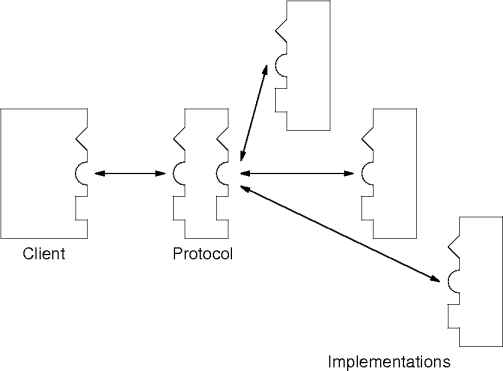
Inheritance
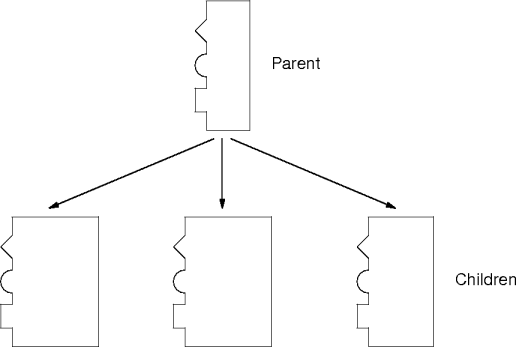
Problems
- Inheritance and protocol classes are overly heavy mechanisms for
implementing IS-A relations.
- “Too much mechanism” means “complexity.”
- Simpler inheritance would be nice, but is technically difficult.
- Simpler protocol classes is a more straightforward, practical solution.
- Not straightforward enough, though.
Abstract Classes
- The
abstractkeyword identifies features intended for protocol definition.- Abstract methods don’t have implementations.
- Abstract classes don’t get instantiated.
- But, a child can have only one parent.
- Or, can only satisfy one protocol.
Interfaces
- An interface is a simpler form of abstract class.
- Abstract methods only, no defined methods.
- All methods are non-static and public.
- All variables are public, static, and final.
- An interface can also contain classes and other interfaces.
Interface Examples
interface Candy {
public abstract int calorieCount();
Nuts [] containsNuts();
boolean hasFlavonoids();
}
interface 3DRectangle {
double height();
double width();
double length();
}
Interface Specifications
- Interfaces can be package-local (default) or public.
- Interfaces can extend other interfaces.
interface ChocolateBar extends Candy { ChocolateKind chocolateKind(); // and so on. }- Interfaces can combine other interfaces too.
public interface ChocolateBar extends Candy, 3DRectangle { ... }
- Interfaces can combine other interfaces too.
Interfaces and Classes
- A class implements one or more interfaces.
class ThreeMusketeers implements ChocolateBar int calorieCount() { ... } boolean hasFlavonoids { return true; } // and so on- A class may implement interfaces and extend a class.
- A class not implementing an interface method becomes abstract.
Constant-Defining Interfaces
- Constant-defining interfaces are frowned upon.
interface Universals { public static final int tearsCried = 96, theAnswer = 42; } - Use one-off classes instead.
abstract class Universals { public static final int tearsCried = 96, theAnswer = 42; }
Trait-Defining Interfaces
- Use interfaces to define traits: small, well-defined
collections of behavior.
interface
Comparableint compareTo(Object o); public interfaceDestroyablevoid destroy(); boolean isDestroyed(); public interfaceReadableint read(CharBuffercb);
Trait Behaviors
- Mix and match traits to give desired behaviors to classes.
class Card implements
Comparableint compareTo(Object o) { ... } // and so on. class SecurityCertificate implementsDestroyable,Readablevoid destroy() { ... } boolean isDestroyed() { ... } int read(CharBuffer cb) { ... } // and so on.
Trait Specifications
- Use traits to specify exactly and minimally what behavior class
instances should have.
boolean beats(
Comparablex) { ... } void validate(Destroyabletag) { ... } Message read(Readableinput) { ... } - The same class instance may have several roles based on traits.
SecurityCertificate ticket = new SecurityCertificate() validate(ticket) Message m = read(ticket)
Interfaces v Abstract Classes
- Which should you use?
- Trait-based “multiple inheritance” favors interfaces.
class banana implements peel, soft {...} class apple implements seeds, crisp {...} - Interfaces form non-hierarchial types.
interface soup extends stock, aromatics {...} interface salad extends greens, dressing {...}
Interfaces & Abstract Classes
- Use an abstract class to provide a default interface implementation.
interface MouseListener void mouseMotion() void mouseButton() // lots more abstract class AbstractMouseListener implements MouseListener public void mouseMotion() { ... } public void mouseButton() { ... } // lots more class TouchPadListener extends AbstractMouseListener public void mouseMotion() { ... }
Class-Instance Danger
- A method can
arbitrarily change
class-instance parameters.
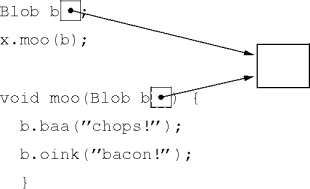
- A source of obscure and dangerous errors.
Class-Instance Safety
- Immutable class instances are safe.
- Hard and maybe impossible to do.
- Pass a copy of the instance.
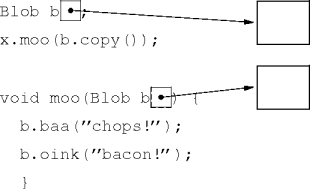
- Problem solved?
Class-Instance Copying
- At first glance, copying seems easy, if possibly expensive.
class T // Or maybe T(T t) T copy() cpy = new T() for each v: this.instance-variable cpy.v = v return cpy
Class-Instance Graphs
- Class instances are graphs.

- A node is a class instance.
- An edge is a reference in an instance variable.
- This structure has important consequences.
Shallow Copies
- The obvious
copy()implements a shallow copy.
- Only the top-level instance is recreated.
- The instance references are copied.
- So?
Why Copy?
- An important reason to copy is to protect a class instance from
unexpected changes.
- A source of nasty errors.
- A shallow copy doesn’t protect against unexpected changes.

Deep Copies
- Protection against unexpected changes requires a deep copy.
- Instance-variable references are recursively copied.
T deepCopy() cpy = new T() for each v: this.instance-variable cpy.v = v.deepCopy() return cpy
Deep-Copy Example
-
Blob cpy = ci.deepCopy()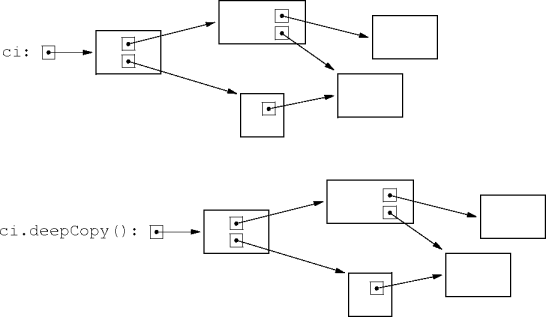
Object.clone()
- The Object method
protected
Objectclone()implements copying.
- It’s another one of those subclass-responsibility Object methods.
- However, by default it’s inaccessible to ancestors and their clients.
No-Clone Example
$ cat t.java
class blob { }
class t {
public static void main(String args[]) {
blob b = new blob();
blob cpy = (blob) b.clone();
}
}
$ javac -Xlint t.java
t.java:7: clone() has protected access
in java.lang.Object
blob cpy = (blob) b.clone();
^
1 error
$
Default Clone
-
Object.clone()implements a shallow copy. - If that’s acceptable, an ancestor must
- implement the
Cloneableinterface, - redeclare
clone()as a public method, and - deal with the clone-unsupported exception.
- implement the
- The Cloneable interface is a hack, not to be emulated.
Shallow-Clone Example
$ cat t.java class blob implementsCloneablepublic blob clone() throws CloneNotSupportedException return (blob) super.clone(); class t public static void main(Stringargs[]) blob b = new blob(); try blob cpy = b.clone(); catch (Exceptione) { } $ javac -Xlint t.java $
Deep-Copying Clones
- If a class needs a deep-copying clone, it
- Overrides
Object.clone()as in a shallow copy, and - The local
clone()implements the deep copy.
- Overrides
- Writing a deep-copy clone is tricky.
- All constituent classes have to provide a deep-copy
clone()too.
- All constituent classes have to provide a deep-copy
Deep-Copy Clone Example
class blob implementsCloneablepublic blob clone() throws CloneNotSupportedException blob b = (blob) super.clone(); // recursively clone instance references. return b; class t public static void main(Stringargs[]) blob b = new blob(); try blob cpy = b.clone(); catch (Exceptione) { }
The Clone Contract
-
Object.clone()has the contract-
x.clone() != x -
x.clone().getClass() == x.getClass() -
x.clone().equals(x)is true.
-
- However these are not “absolute requirements”.
- Immutable instances may clone to themselves, for example.
Summary
- Interfaces are lightweight abstract classes.
- Favor interface types over abstract-class types.
- Use interfaces to define traits and types.
- Determine copying behavior if any and override
Object.clone()appropriately.- Think hard about implementing deep copying.
References
- Items 10 (Override
clonejudiciously), 16 (Prefer interfaces to abstract classes), and 17 (Use interfaces only to define types) from Effective Java by Joshua Bloch, Addison-Wesley, 2001.
